Teamwork in the Workplace (pdf)
VerifiedAdded on 2021/06/16
|16
|3643
|24
AI Summary
Contribute Materials
Your contribution can guide someone’s learning journey. Share your
documents today.
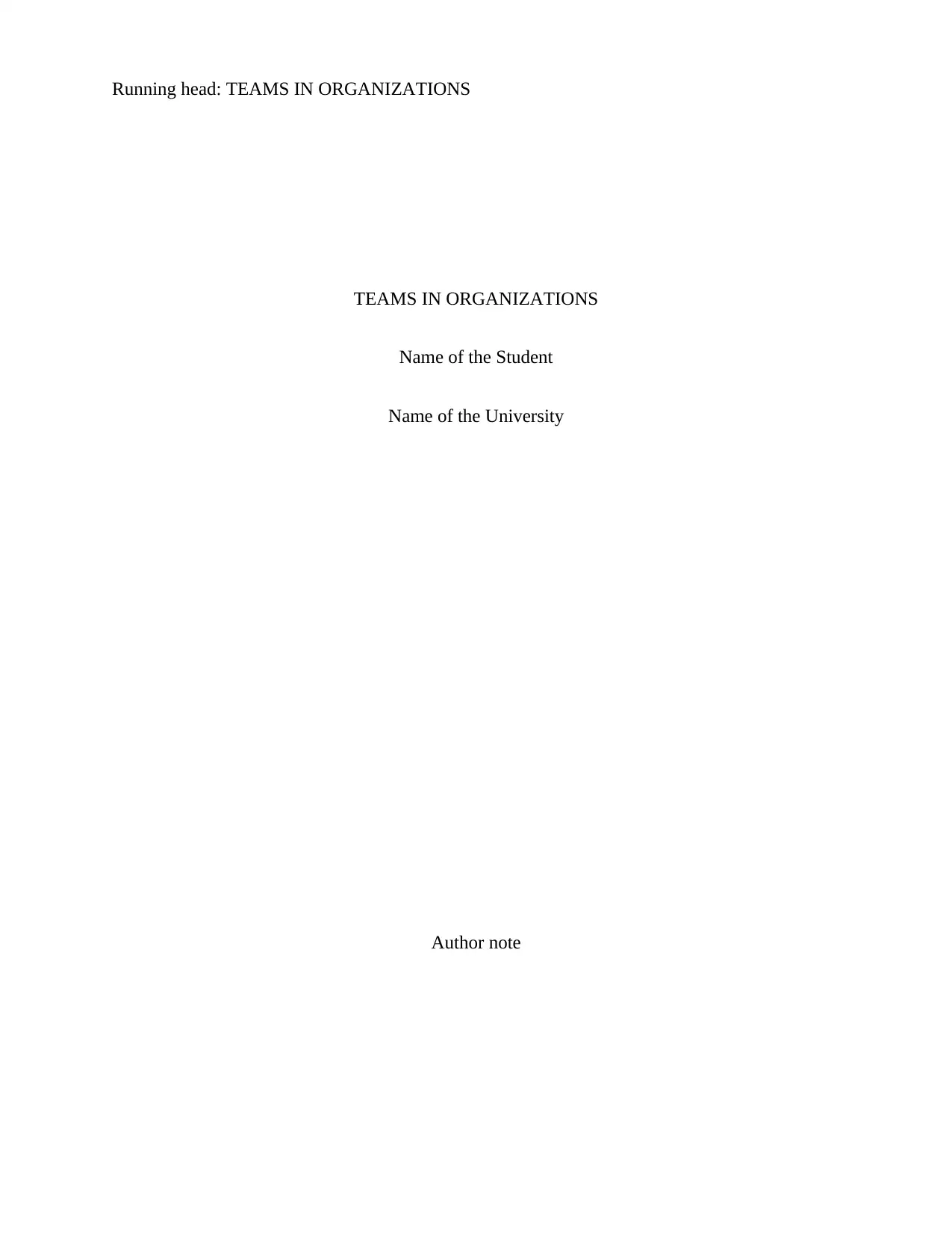
Running head: TEAMS IN ORGANIZATIONS
TEAMS IN ORGANIZATIONS
Name of the Student
Name of the University
Author note
TEAMS IN ORGANIZATIONS
Name of the Student
Name of the University
Author note
Secure Best Marks with AI Grader
Need help grading? Try our AI Grader for instant feedback on your assignments.
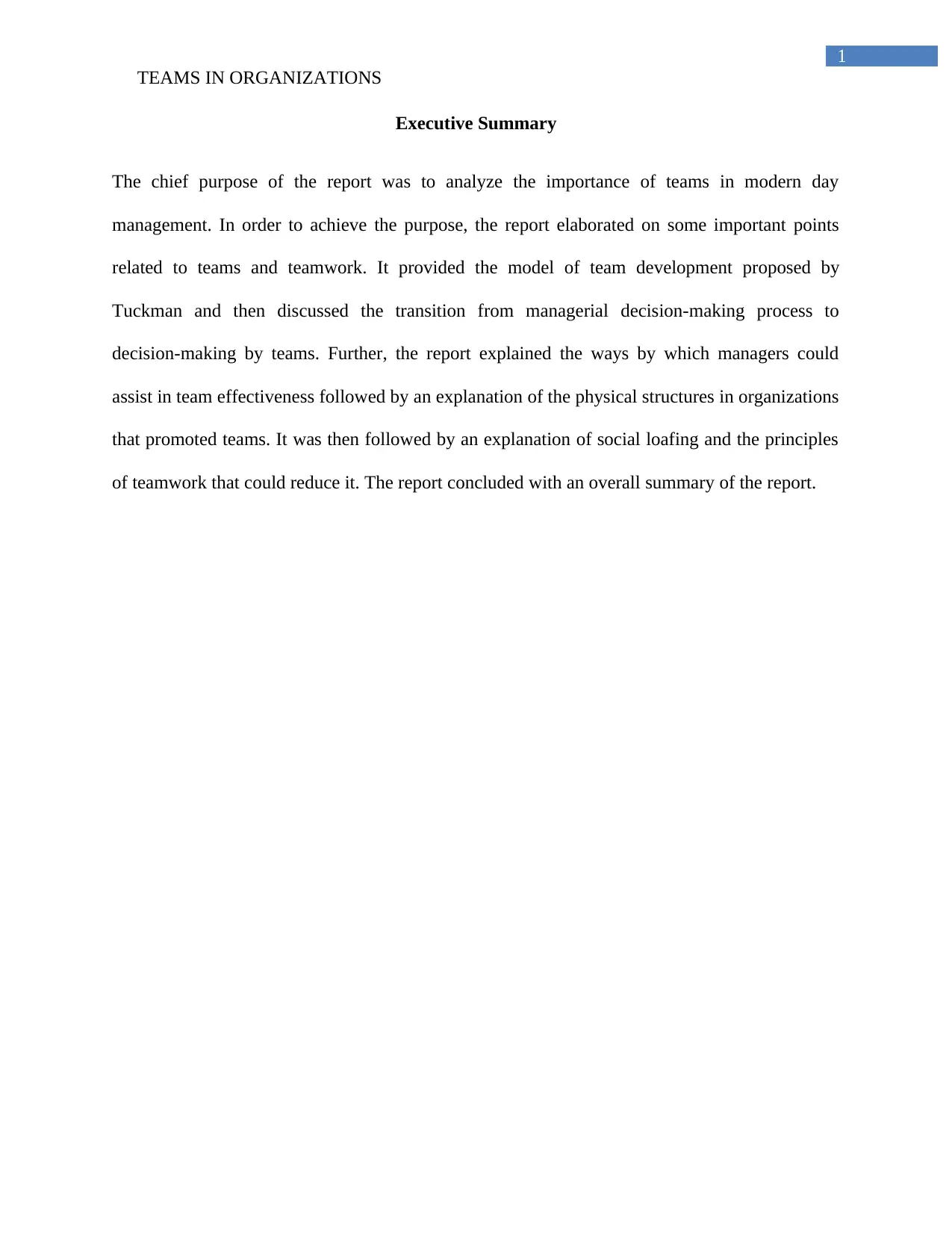
1
TEAMS IN ORGANIZATIONS
Executive Summary
The chief purpose of the report was to analyze the importance of teams in modern day
management. In order to achieve the purpose, the report elaborated on some important points
related to teams and teamwork. It provided the model of team development proposed by
Tuckman and then discussed the transition from managerial decision-making process to
decision-making by teams. Further, the report explained the ways by which managers could
assist in team effectiveness followed by an explanation of the physical structures in organizations
that promoted teams. It was then followed by an explanation of social loafing and the principles
of teamwork that could reduce it. The report concluded with an overall summary of the report.
TEAMS IN ORGANIZATIONS
Executive Summary
The chief purpose of the report was to analyze the importance of teams in modern day
management. In order to achieve the purpose, the report elaborated on some important points
related to teams and teamwork. It provided the model of team development proposed by
Tuckman and then discussed the transition from managerial decision-making process to
decision-making by teams. Further, the report explained the ways by which managers could
assist in team effectiveness followed by an explanation of the physical structures in organizations
that promoted teams. It was then followed by an explanation of social loafing and the principles
of teamwork that could reduce it. The report concluded with an overall summary of the report.
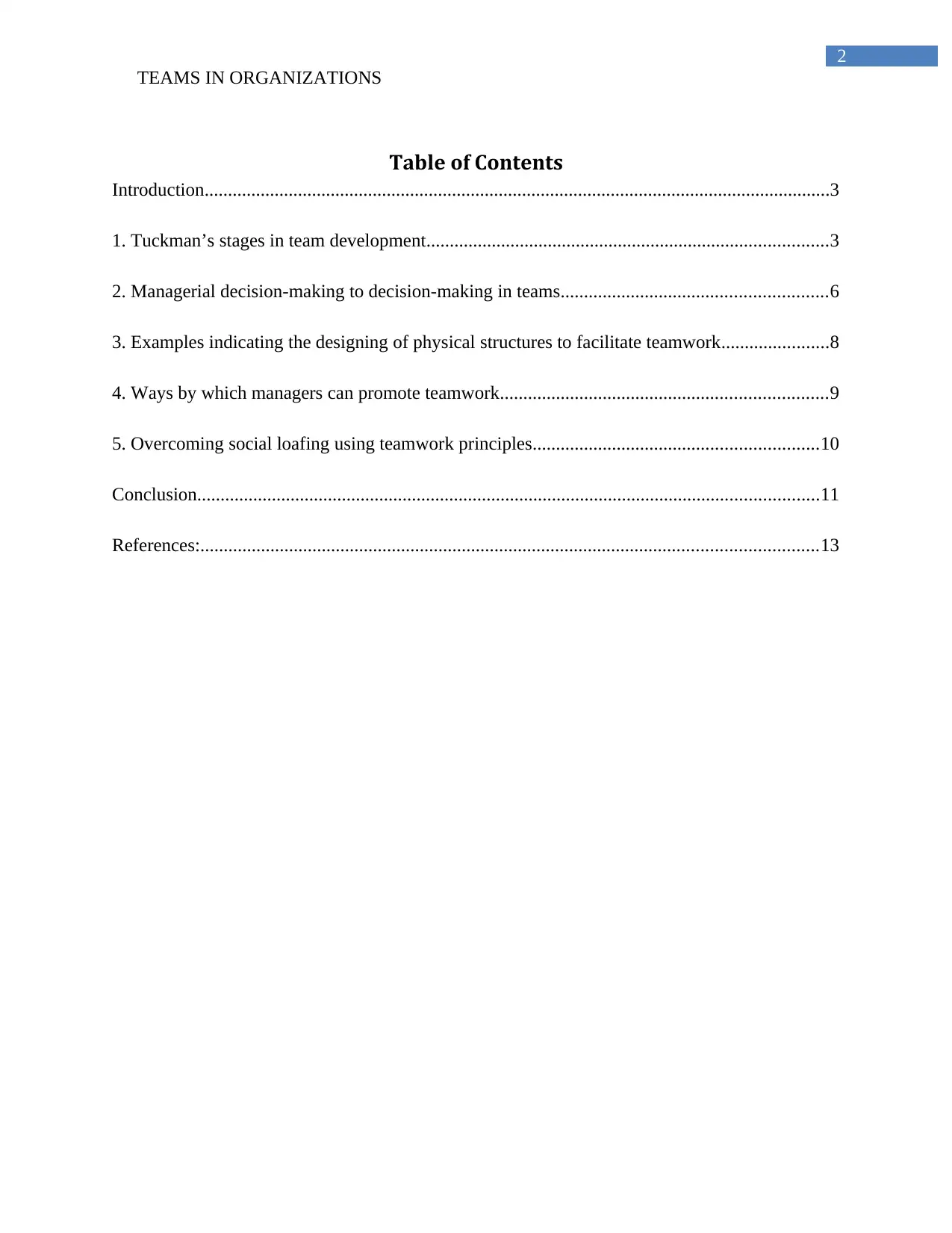
2
TEAMS IN ORGANIZATIONS
Table of Contents
Introduction......................................................................................................................................3
1. Tuckman’s stages in team development......................................................................................3
2. Managerial decision-making to decision-making in teams.........................................................6
3. Examples indicating the designing of physical structures to facilitate teamwork.......................8
4. Ways by which managers can promote teamwork......................................................................9
5. Overcoming social loafing using teamwork principles.............................................................10
Conclusion.....................................................................................................................................11
References:....................................................................................................................................13
TEAMS IN ORGANIZATIONS
Table of Contents
Introduction......................................................................................................................................3
1. Tuckman’s stages in team development......................................................................................3
2. Managerial decision-making to decision-making in teams.........................................................6
3. Examples indicating the designing of physical structures to facilitate teamwork.......................8
4. Ways by which managers can promote teamwork......................................................................9
5. Overcoming social loafing using teamwork principles.............................................................10
Conclusion.....................................................................................................................................11
References:....................................................................................................................................13
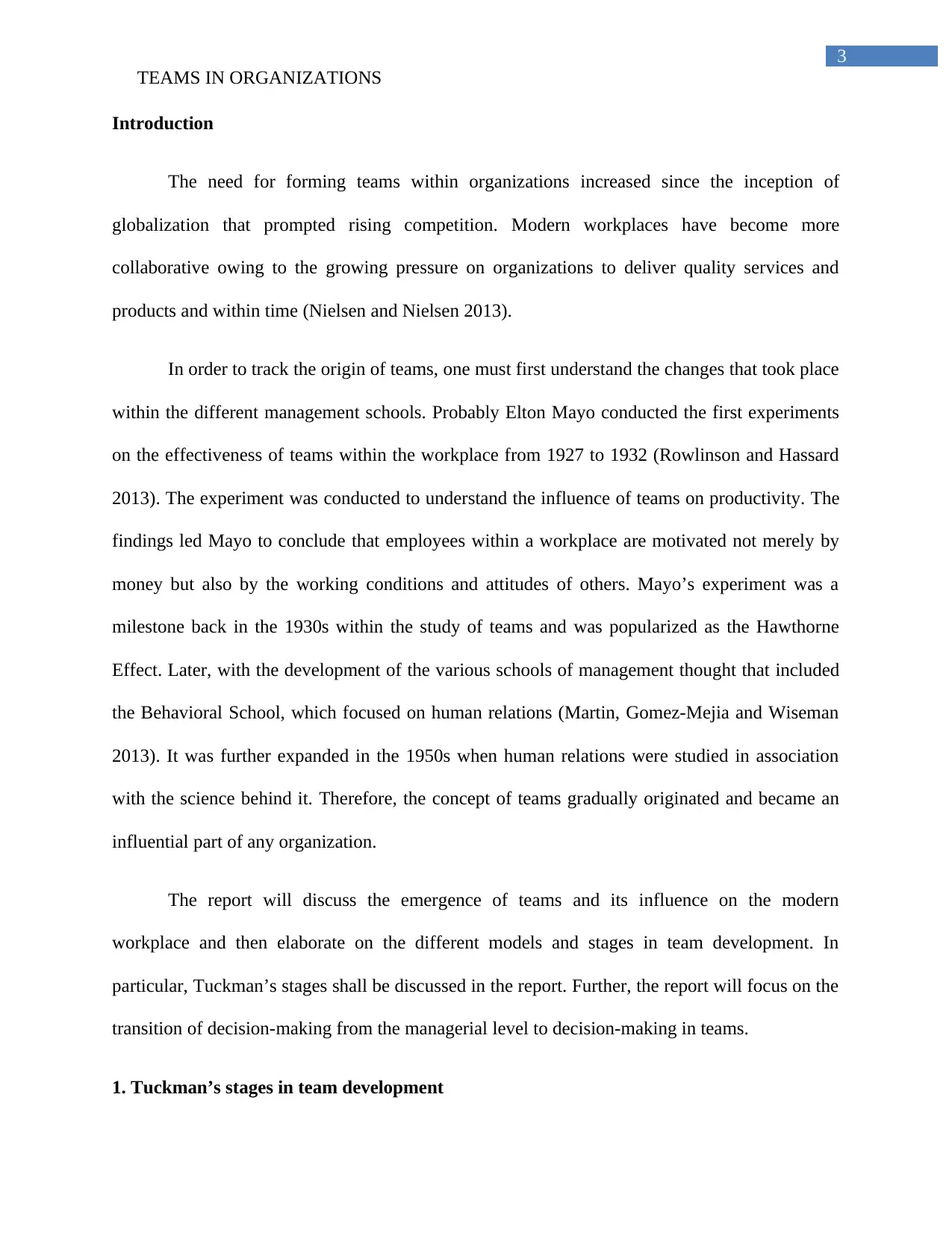
3
TEAMS IN ORGANIZATIONS
Introduction
The need for forming teams within organizations increased since the inception of
globalization that prompted rising competition. Modern workplaces have become more
collaborative owing to the growing pressure on organizations to deliver quality services and
products and within time (Nielsen and Nielsen 2013).
In order to track the origin of teams, one must first understand the changes that took place
within the different management schools. Probably Elton Mayo conducted the first experiments
on the effectiveness of teams within the workplace from 1927 to 1932 (Rowlinson and Hassard
2013). The experiment was conducted to understand the influence of teams on productivity. The
findings led Mayo to conclude that employees within a workplace are motivated not merely by
money but also by the working conditions and attitudes of others. Mayo’s experiment was a
milestone back in the 1930s within the study of teams and was popularized as the Hawthorne
Effect. Later, with the development of the various schools of management thought that included
the Behavioral School, which focused on human relations (Martin, Gomez-Mejia and Wiseman
2013). It was further expanded in the 1950s when human relations were studied in association
with the science behind it. Therefore, the concept of teams gradually originated and became an
influential part of any organization.
The report will discuss the emergence of teams and its influence on the modern
workplace and then elaborate on the different models and stages in team development. In
particular, Tuckman’s stages shall be discussed in the report. Further, the report will focus on the
transition of decision-making from the managerial level to decision-making in teams.
1. Tuckman’s stages in team development
TEAMS IN ORGANIZATIONS
Introduction
The need for forming teams within organizations increased since the inception of
globalization that prompted rising competition. Modern workplaces have become more
collaborative owing to the growing pressure on organizations to deliver quality services and
products and within time (Nielsen and Nielsen 2013).
In order to track the origin of teams, one must first understand the changes that took place
within the different management schools. Probably Elton Mayo conducted the first experiments
on the effectiveness of teams within the workplace from 1927 to 1932 (Rowlinson and Hassard
2013). The experiment was conducted to understand the influence of teams on productivity. The
findings led Mayo to conclude that employees within a workplace are motivated not merely by
money but also by the working conditions and attitudes of others. Mayo’s experiment was a
milestone back in the 1930s within the study of teams and was popularized as the Hawthorne
Effect. Later, with the development of the various schools of management thought that included
the Behavioral School, which focused on human relations (Martin, Gomez-Mejia and Wiseman
2013). It was further expanded in the 1950s when human relations were studied in association
with the science behind it. Therefore, the concept of teams gradually originated and became an
influential part of any organization.
The report will discuss the emergence of teams and its influence on the modern
workplace and then elaborate on the different models and stages in team development. In
particular, Tuckman’s stages shall be discussed in the report. Further, the report will focus on the
transition of decision-making from the managerial level to decision-making in teams.
1. Tuckman’s stages in team development
Secure Best Marks with AI Grader
Need help grading? Try our AI Grader for instant feedback on your assignments.
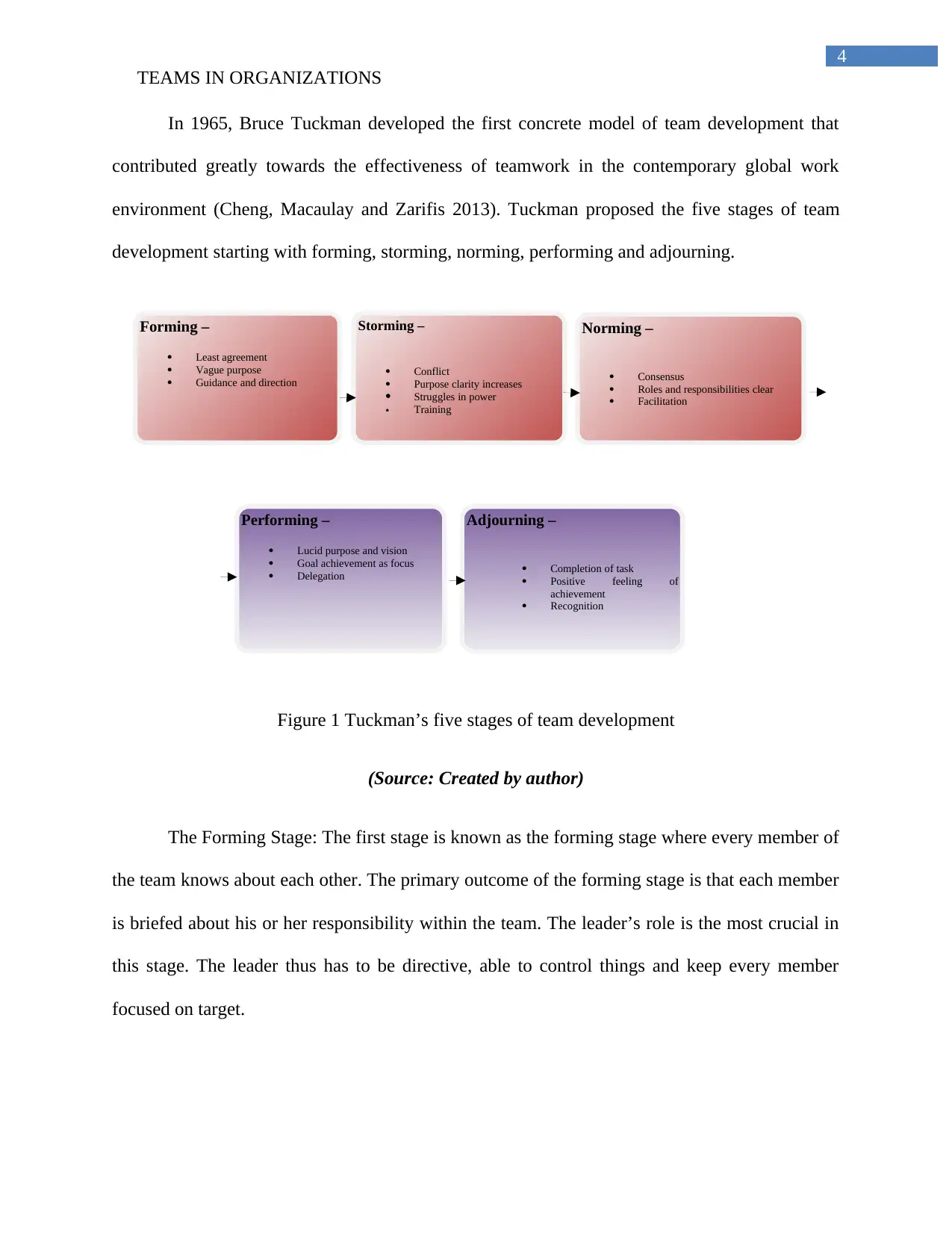
4
TEAMS IN ORGANIZATIONS
In 1965, Bruce Tuckman developed the first concrete model of team development that
contributed greatly towards the effectiveness of teamwork in the contemporary global work
environment (Cheng, Macaulay and Zarifis 2013). Tuckman proposed the five stages of team
development starting with forming, storming, norming, performing and adjourning.
Figure 1 Tuckman’s five stages of team development
(Source: Created by author)
The Forming Stage: The first stage is known as the forming stage where every member of
the team knows about each other. The primary outcome of the forming stage is that each member
is briefed about his or her responsibility within the team. The leader’s role is the most crucial in
this stage. The leader thus has to be directive, able to control things and keep every member
focused on target.
Adjourning –
Completion of task
Positive feeling of
achievement
Recognition
Performing –
Lucid purpose and vision
Goal achievement as focus
Delegation
Forming –
Least agreement
Vague purpose
Guidance and direction
Storming –
Conflict
Purpose clarity increases
Struggles in power
Training
Norming –
Consensus
Roles and responsibilities clear
Facilitation
TEAMS IN ORGANIZATIONS
In 1965, Bruce Tuckman developed the first concrete model of team development that
contributed greatly towards the effectiveness of teamwork in the contemporary global work
environment (Cheng, Macaulay and Zarifis 2013). Tuckman proposed the five stages of team
development starting with forming, storming, norming, performing and adjourning.
Figure 1 Tuckman’s five stages of team development
(Source: Created by author)
The Forming Stage: The first stage is known as the forming stage where every member of
the team knows about each other. The primary outcome of the forming stage is that each member
is briefed about his or her responsibility within the team. The leader’s role is the most crucial in
this stage. The leader thus has to be directive, able to control things and keep every member
focused on target.
Adjourning –
Completion of task
Positive feeling of
achievement
Recognition
Performing –
Lucid purpose and vision
Goal achievement as focus
Delegation
Forming –
Least agreement
Vague purpose
Guidance and direction
Storming –
Conflict
Purpose clarity increases
Struggles in power
Training
Norming –
Consensus
Roles and responsibilities clear
Facilitation
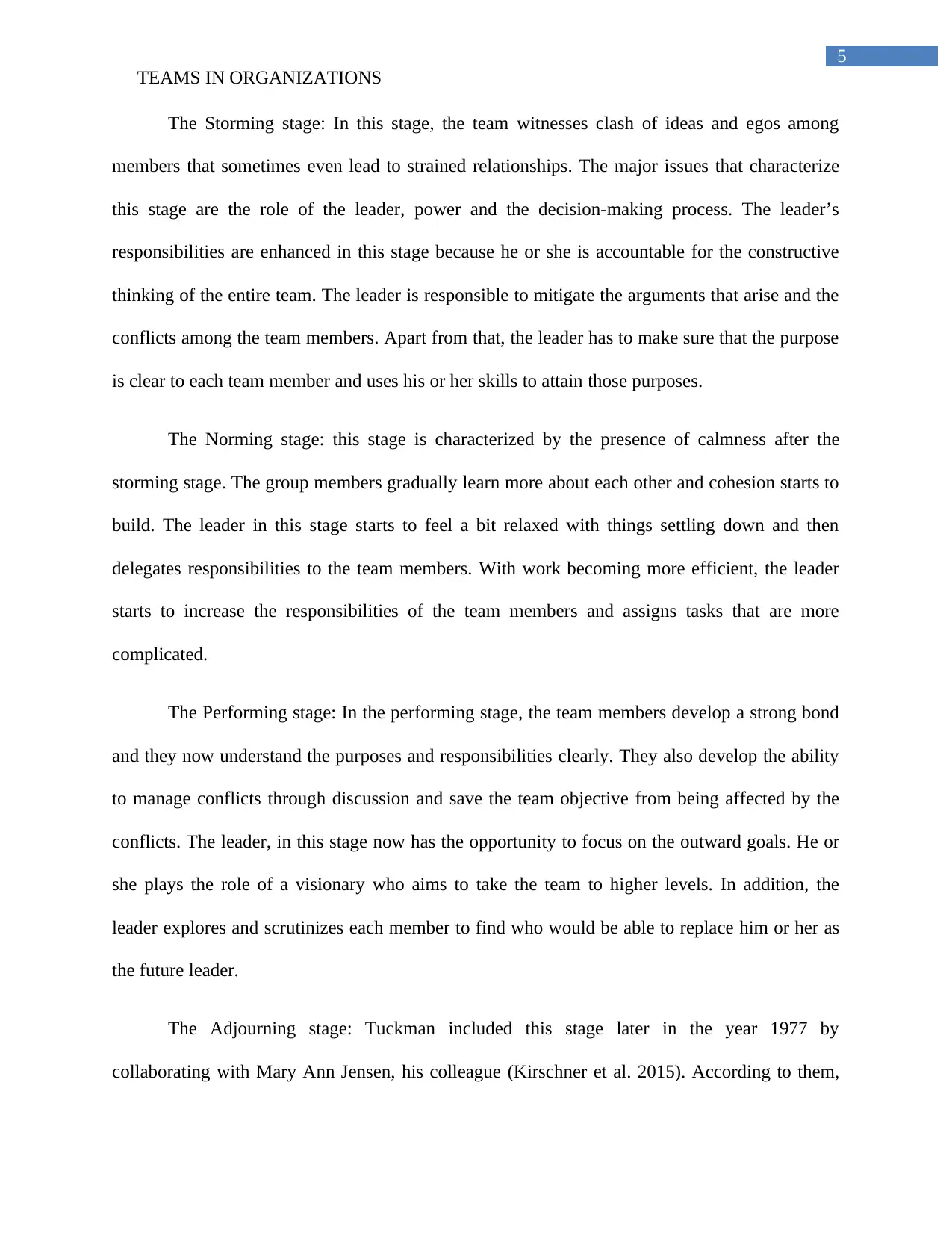
5
TEAMS IN ORGANIZATIONS
The Storming stage: In this stage, the team witnesses clash of ideas and egos among
members that sometimes even lead to strained relationships. The major issues that characterize
this stage are the role of the leader, power and the decision-making process. The leader’s
responsibilities are enhanced in this stage because he or she is accountable for the constructive
thinking of the entire team. The leader is responsible to mitigate the arguments that arise and the
conflicts among the team members. Apart from that, the leader has to make sure that the purpose
is clear to each team member and uses his or her skills to attain those purposes.
The Norming stage: this stage is characterized by the presence of calmness after the
storming stage. The group members gradually learn more about each other and cohesion starts to
build. The leader in this stage starts to feel a bit relaxed with things settling down and then
delegates responsibilities to the team members. With work becoming more efficient, the leader
starts to increase the responsibilities of the team members and assigns tasks that are more
complicated.
The Performing stage: In the performing stage, the team members develop a strong bond
and they now understand the purposes and responsibilities clearly. They also develop the ability
to manage conflicts through discussion and save the team objective from being affected by the
conflicts. The leader, in this stage now has the opportunity to focus on the outward goals. He or
she plays the role of a visionary who aims to take the team to higher levels. In addition, the
leader explores and scrutinizes each member to find who would be able to replace him or her as
the future leader.
The Adjourning stage: Tuckman included this stage later in the year 1977 by
collaborating with Mary Ann Jensen, his colleague (Kirschner et al. 2015). According to them,
TEAMS IN ORGANIZATIONS
The Storming stage: In this stage, the team witnesses clash of ideas and egos among
members that sometimes even lead to strained relationships. The major issues that characterize
this stage are the role of the leader, power and the decision-making process. The leader’s
responsibilities are enhanced in this stage because he or she is accountable for the constructive
thinking of the entire team. The leader is responsible to mitigate the arguments that arise and the
conflicts among the team members. Apart from that, the leader has to make sure that the purpose
is clear to each team member and uses his or her skills to attain those purposes.
The Norming stage: this stage is characterized by the presence of calmness after the
storming stage. The group members gradually learn more about each other and cohesion starts to
build. The leader in this stage starts to feel a bit relaxed with things settling down and then
delegates responsibilities to the team members. With work becoming more efficient, the leader
starts to increase the responsibilities of the team members and assigns tasks that are more
complicated.
The Performing stage: In the performing stage, the team members develop a strong bond
and they now understand the purposes and responsibilities clearly. They also develop the ability
to manage conflicts through discussion and save the team objective from being affected by the
conflicts. The leader, in this stage now has the opportunity to focus on the outward goals. He or
she plays the role of a visionary who aims to take the team to higher levels. In addition, the
leader explores and scrutinizes each member to find who would be able to replace him or her as
the future leader.
The Adjourning stage: Tuckman included this stage later in the year 1977 by
collaborating with Mary Ann Jensen, his colleague (Kirschner et al. 2015). According to them,
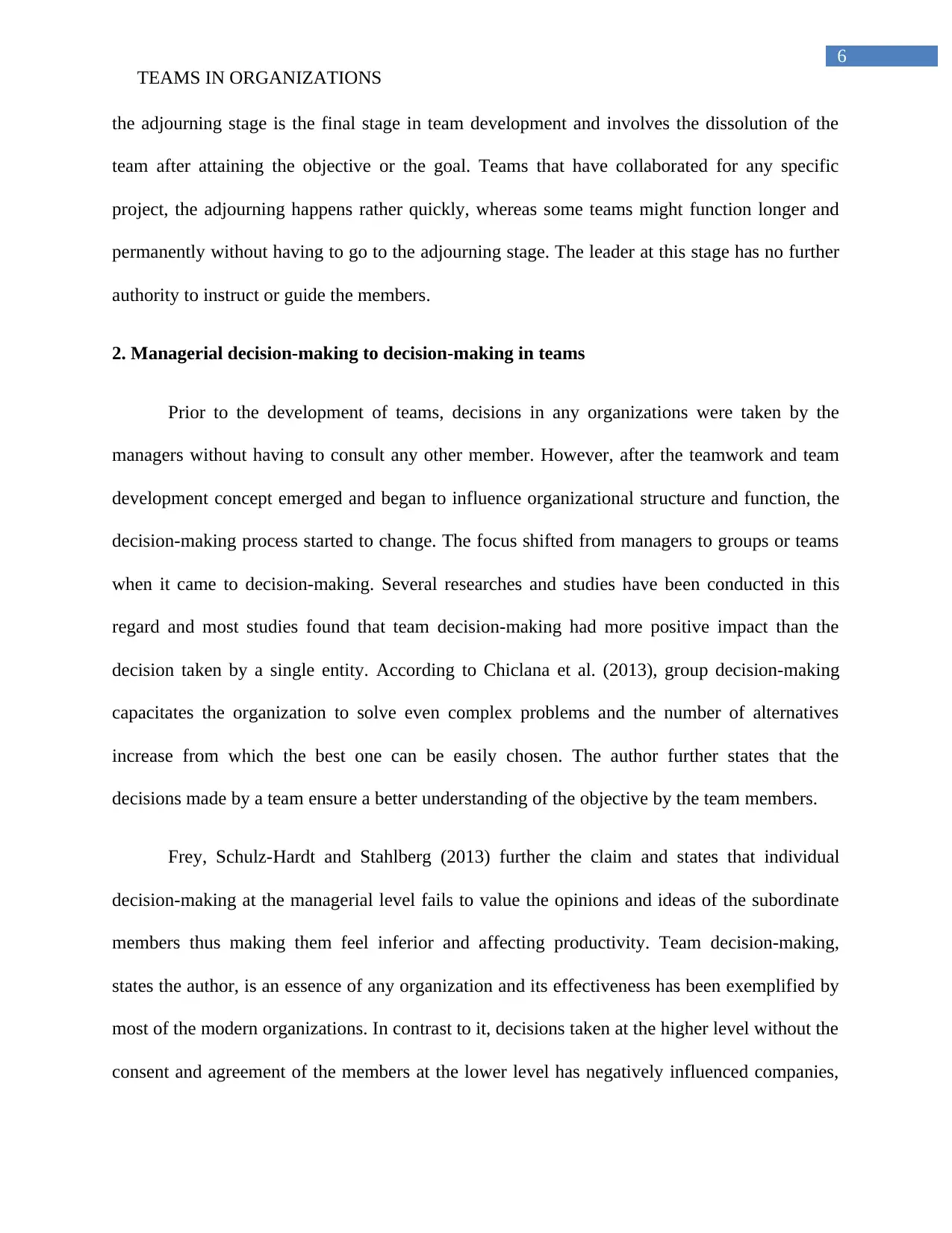
6
TEAMS IN ORGANIZATIONS
the adjourning stage is the final stage in team development and involves the dissolution of the
team after attaining the objective or the goal. Teams that have collaborated for any specific
project, the adjourning happens rather quickly, whereas some teams might function longer and
permanently without having to go to the adjourning stage. The leader at this stage has no further
authority to instruct or guide the members.
2. Managerial decision-making to decision-making in teams
Prior to the development of teams, decisions in any organizations were taken by the
managers without having to consult any other member. However, after the teamwork and team
development concept emerged and began to influence organizational structure and function, the
decision-making process started to change. The focus shifted from managers to groups or teams
when it came to decision-making. Several researches and studies have been conducted in this
regard and most studies found that team decision-making had more positive impact than the
decision taken by a single entity. According to Chiclana et al. (2013), group decision-making
capacitates the organization to solve even complex problems and the number of alternatives
increase from which the best one can be easily chosen. The author further states that the
decisions made by a team ensure a better understanding of the objective by the team members.
Frey, Schulz-Hardt and Stahlberg (2013) further the claim and states that individual
decision-making at the managerial level fails to value the opinions and ideas of the subordinate
members thus making them feel inferior and affecting productivity. Team decision-making,
states the author, is an essence of any organization and its effectiveness has been exemplified by
most of the modern organizations. In contrast to it, decisions taken at the higher level without the
consent and agreement of the members at the lower level has negatively influenced companies,
TEAMS IN ORGANIZATIONS
the adjourning stage is the final stage in team development and involves the dissolution of the
team after attaining the objective or the goal. Teams that have collaborated for any specific
project, the adjourning happens rather quickly, whereas some teams might function longer and
permanently without having to go to the adjourning stage. The leader at this stage has no further
authority to instruct or guide the members.
2. Managerial decision-making to decision-making in teams
Prior to the development of teams, decisions in any organizations were taken by the
managers without having to consult any other member. However, after the teamwork and team
development concept emerged and began to influence organizational structure and function, the
decision-making process started to change. The focus shifted from managers to groups or teams
when it came to decision-making. Several researches and studies have been conducted in this
regard and most studies found that team decision-making had more positive impact than the
decision taken by a single entity. According to Chiclana et al. (2013), group decision-making
capacitates the organization to solve even complex problems and the number of alternatives
increase from which the best one can be easily chosen. The author further states that the
decisions made by a team ensure a better understanding of the objective by the team members.
Frey, Schulz-Hardt and Stahlberg (2013) further the claim and states that individual
decision-making at the managerial level fails to value the opinions and ideas of the subordinate
members thus making them feel inferior and affecting productivity. Team decision-making,
states the author, is an essence of any organization and its effectiveness has been exemplified by
most of the modern organizations. In contrast to it, decisions taken at the higher level without the
consent and agreement of the members at the lower level has negatively influenced companies,
Paraphrase This Document
Need a fresh take? Get an instant paraphrase of this document with our AI Paraphraser
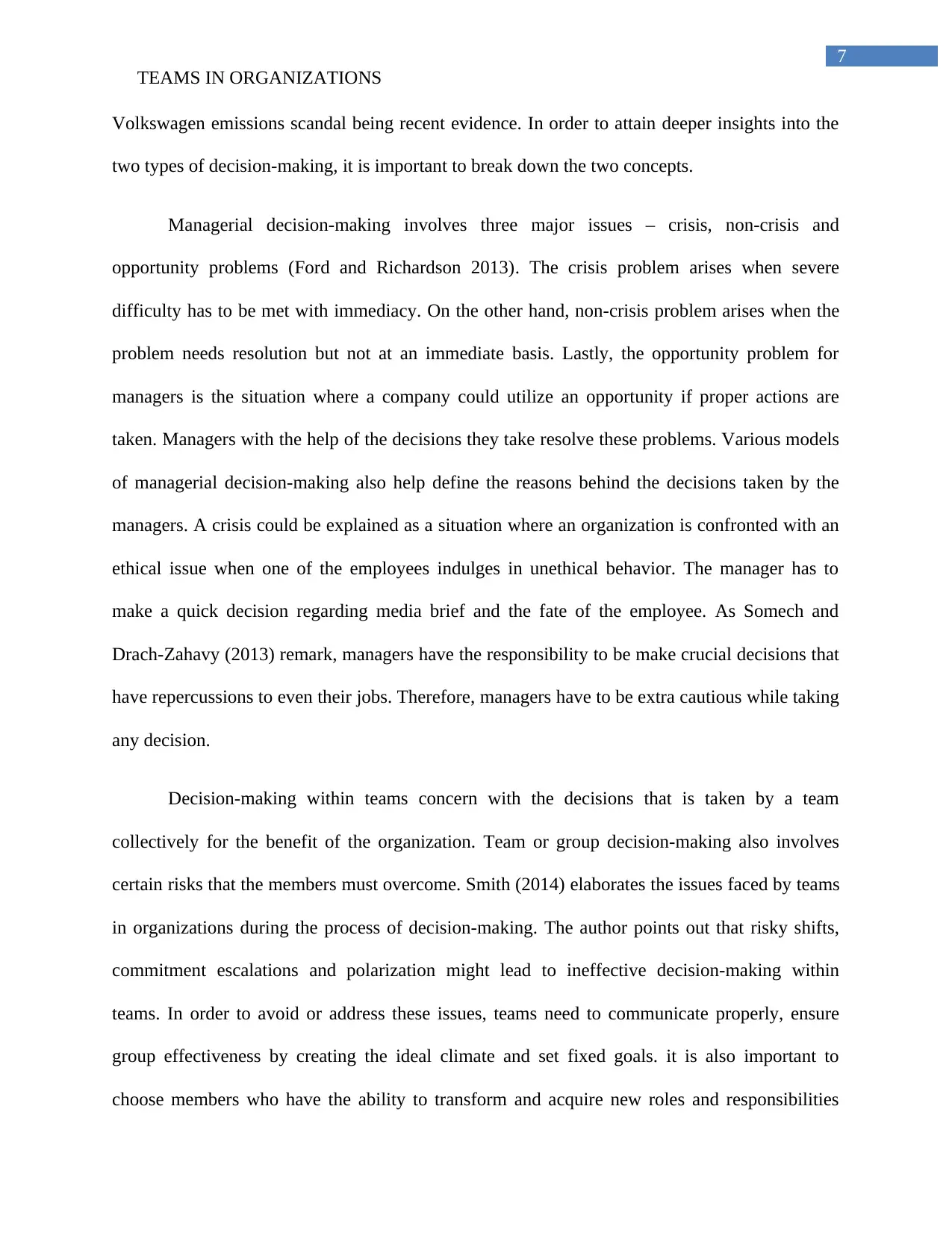
7
TEAMS IN ORGANIZATIONS
Volkswagen emissions scandal being recent evidence. In order to attain deeper insights into the
two types of decision-making, it is important to break down the two concepts.
Managerial decision-making involves three major issues – crisis, non-crisis and
opportunity problems (Ford and Richardson 2013). The crisis problem arises when severe
difficulty has to be met with immediacy. On the other hand, non-crisis problem arises when the
problem needs resolution but not at an immediate basis. Lastly, the opportunity problem for
managers is the situation where a company could utilize an opportunity if proper actions are
taken. Managers with the help of the decisions they take resolve these problems. Various models
of managerial decision-making also help define the reasons behind the decisions taken by the
managers. A crisis could be explained as a situation where an organization is confronted with an
ethical issue when one of the employees indulges in unethical behavior. The manager has to
make a quick decision regarding media brief and the fate of the employee. As Somech and
Drach-Zahavy (2013) remark, managers have the responsibility to be make crucial decisions that
have repercussions to even their jobs. Therefore, managers have to be extra cautious while taking
any decision.
Decision-making within teams concern with the decisions that is taken by a team
collectively for the benefit of the organization. Team or group decision-making also involves
certain risks that the members must overcome. Smith (2014) elaborates the issues faced by teams
in organizations during the process of decision-making. The author points out that risky shifts,
commitment escalations and polarization might lead to ineffective decision-making within
teams. In order to avoid or address these issues, teams need to communicate properly, ensure
group effectiveness by creating the ideal climate and set fixed goals. it is also important to
choose members who have the ability to transform and acquire new roles and responsibilities
TEAMS IN ORGANIZATIONS
Volkswagen emissions scandal being recent evidence. In order to attain deeper insights into the
two types of decision-making, it is important to break down the two concepts.
Managerial decision-making involves three major issues – crisis, non-crisis and
opportunity problems (Ford and Richardson 2013). The crisis problem arises when severe
difficulty has to be met with immediacy. On the other hand, non-crisis problem arises when the
problem needs resolution but not at an immediate basis. Lastly, the opportunity problem for
managers is the situation where a company could utilize an opportunity if proper actions are
taken. Managers with the help of the decisions they take resolve these problems. Various models
of managerial decision-making also help define the reasons behind the decisions taken by the
managers. A crisis could be explained as a situation where an organization is confronted with an
ethical issue when one of the employees indulges in unethical behavior. The manager has to
make a quick decision regarding media brief and the fate of the employee. As Somech and
Drach-Zahavy (2013) remark, managers have the responsibility to be make crucial decisions that
have repercussions to even their jobs. Therefore, managers have to be extra cautious while taking
any decision.
Decision-making within teams concern with the decisions that is taken by a team
collectively for the benefit of the organization. Team or group decision-making also involves
certain risks that the members must overcome. Smith (2014) elaborates the issues faced by teams
in organizations during the process of decision-making. The author points out that risky shifts,
commitment escalations and polarization might lead to ineffective decision-making within
teams. In order to avoid or address these issues, teams need to communicate properly, ensure
group effectiveness by creating the ideal climate and set fixed goals. it is also important to
choose members who have the ability to transform and acquire new roles and responsibilities
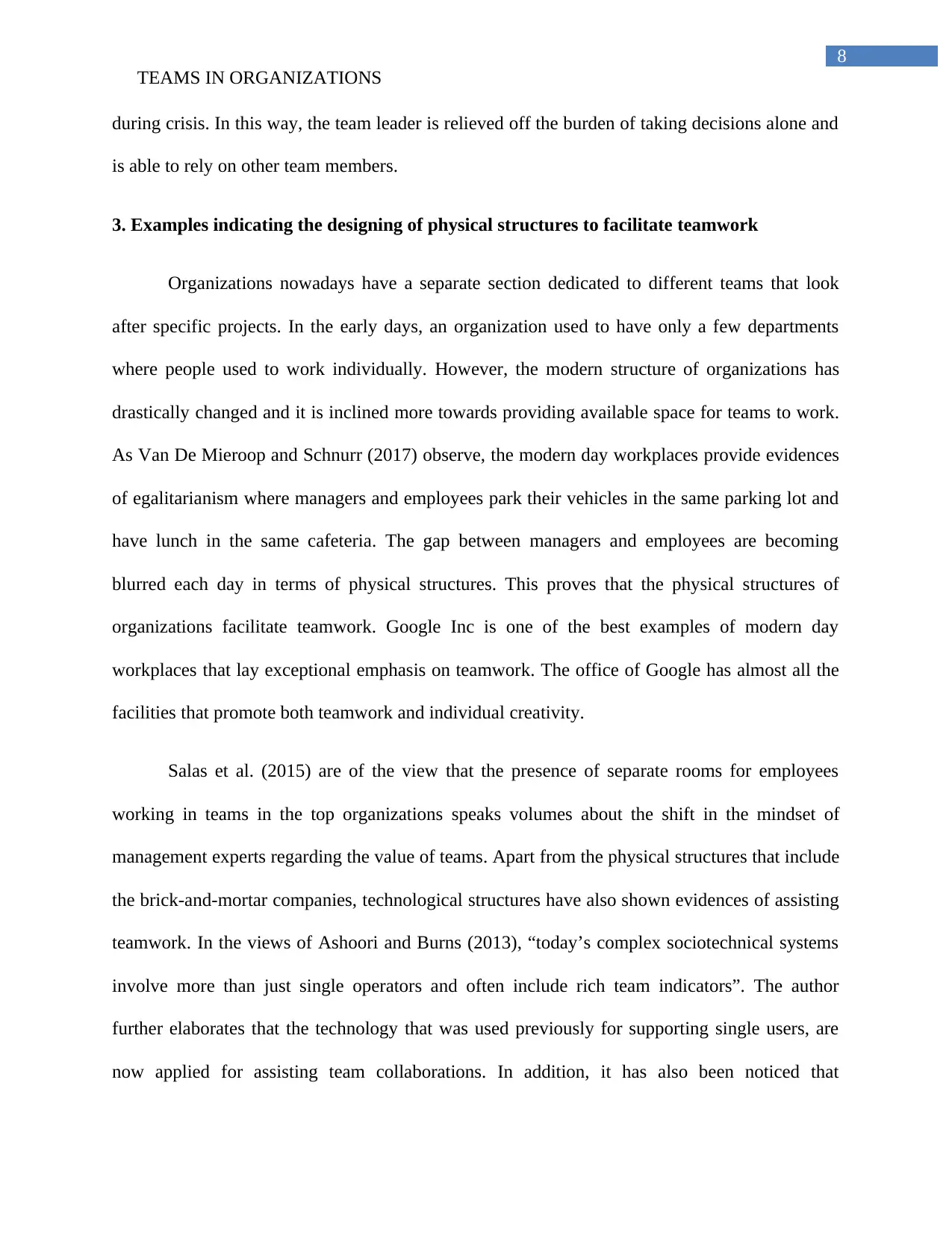
8
TEAMS IN ORGANIZATIONS
during crisis. In this way, the team leader is relieved off the burden of taking decisions alone and
is able to rely on other team members.
3. Examples indicating the designing of physical structures to facilitate teamwork
Organizations nowadays have a separate section dedicated to different teams that look
after specific projects. In the early days, an organization used to have only a few departments
where people used to work individually. However, the modern structure of organizations has
drastically changed and it is inclined more towards providing available space for teams to work.
As Van De Mieroop and Schnurr (2017) observe, the modern day workplaces provide evidences
of egalitarianism where managers and employees park their vehicles in the same parking lot and
have lunch in the same cafeteria. The gap between managers and employees are becoming
blurred each day in terms of physical structures. This proves that the physical structures of
organizations facilitate teamwork. Google Inc is one of the best examples of modern day
workplaces that lay exceptional emphasis on teamwork. The office of Google has almost all the
facilities that promote both teamwork and individual creativity.
Salas et al. (2015) are of the view that the presence of separate rooms for employees
working in teams in the top organizations speaks volumes about the shift in the mindset of
management experts regarding the value of teams. Apart from the physical structures that include
the brick-and-mortar companies, technological structures have also shown evidences of assisting
teamwork. In the views of Ashoori and Burns (2013), “today’s complex sociotechnical systems
involve more than just single operators and often include rich team indicators”. The author
further elaborates that the technology that was used previously for supporting single users, are
now applied for assisting team collaborations. In addition, it has also been noticed that
TEAMS IN ORGANIZATIONS
during crisis. In this way, the team leader is relieved off the burden of taking decisions alone and
is able to rely on other team members.
3. Examples indicating the designing of physical structures to facilitate teamwork
Organizations nowadays have a separate section dedicated to different teams that look
after specific projects. In the early days, an organization used to have only a few departments
where people used to work individually. However, the modern structure of organizations has
drastically changed and it is inclined more towards providing available space for teams to work.
As Van De Mieroop and Schnurr (2017) observe, the modern day workplaces provide evidences
of egalitarianism where managers and employees park their vehicles in the same parking lot and
have lunch in the same cafeteria. The gap between managers and employees are becoming
blurred each day in terms of physical structures. This proves that the physical structures of
organizations facilitate teamwork. Google Inc is one of the best examples of modern day
workplaces that lay exceptional emphasis on teamwork. The office of Google has almost all the
facilities that promote both teamwork and individual creativity.
Salas et al. (2015) are of the view that the presence of separate rooms for employees
working in teams in the top organizations speaks volumes about the shift in the mindset of
management experts regarding the value of teams. Apart from the physical structures that include
the brick-and-mortar companies, technological structures have also shown evidences of assisting
teamwork. In the views of Ashoori and Burns (2013), “today’s complex sociotechnical systems
involve more than just single operators and often include rich team indicators”. The author
further elaborates that the technology that was used previously for supporting single users, are
now applied for assisting team collaborations. In addition, it has also been noticed that
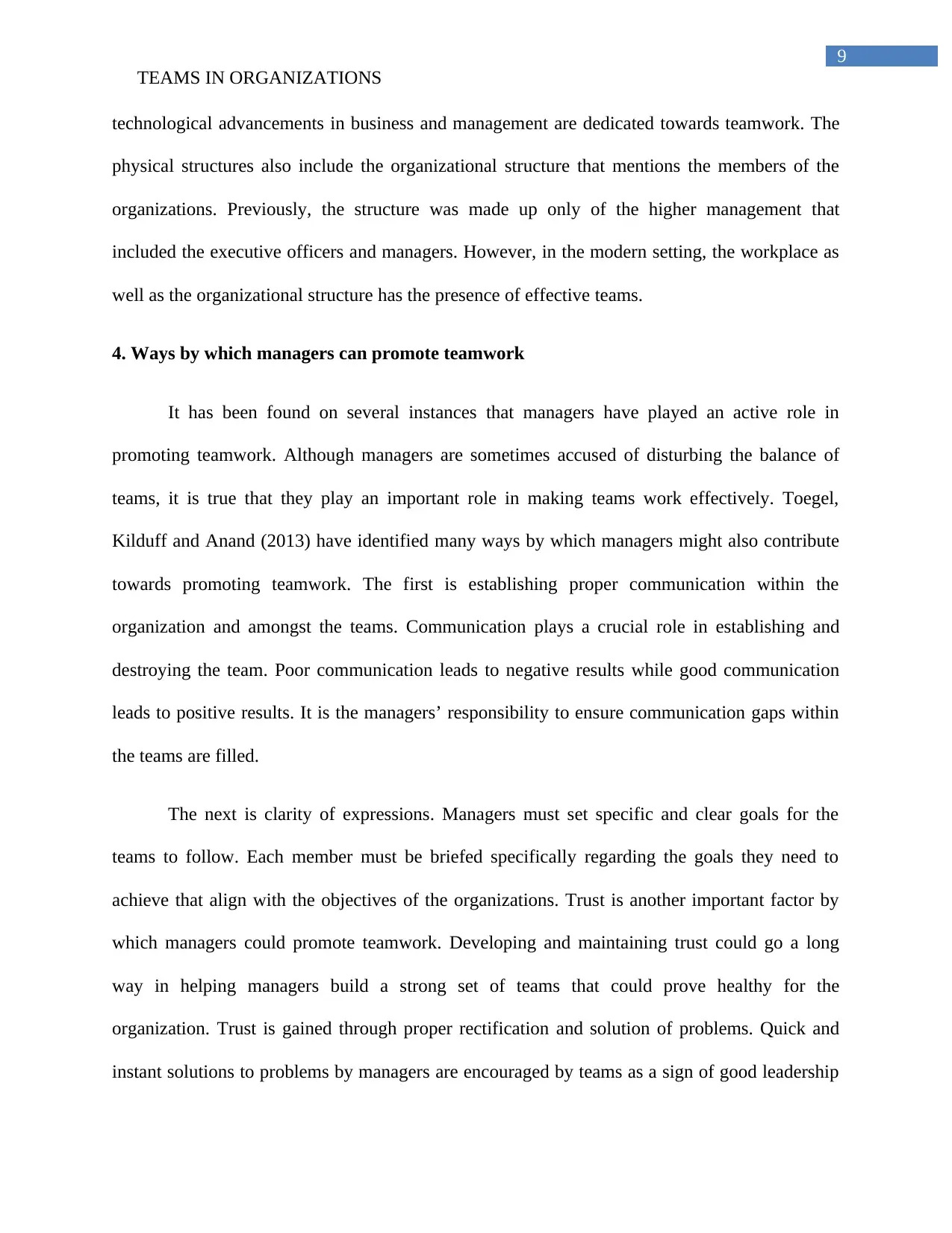
9
TEAMS IN ORGANIZATIONS
technological advancements in business and management are dedicated towards teamwork. The
physical structures also include the organizational structure that mentions the members of the
organizations. Previously, the structure was made up only of the higher management that
included the executive officers and managers. However, in the modern setting, the workplace as
well as the organizational structure has the presence of effective teams.
4. Ways by which managers can promote teamwork
It has been found on several instances that managers have played an active role in
promoting teamwork. Although managers are sometimes accused of disturbing the balance of
teams, it is true that they play an important role in making teams work effectively. Toegel,
Kilduff and Anand (2013) have identified many ways by which managers might also contribute
towards promoting teamwork. The first is establishing proper communication within the
organization and amongst the teams. Communication plays a crucial role in establishing and
destroying the team. Poor communication leads to negative results while good communication
leads to positive results. It is the managers’ responsibility to ensure communication gaps within
the teams are filled.
The next is clarity of expressions. Managers must set specific and clear goals for the
teams to follow. Each member must be briefed specifically regarding the goals they need to
achieve that align with the objectives of the organizations. Trust is another important factor by
which managers could promote teamwork. Developing and maintaining trust could go a long
way in helping managers build a strong set of teams that could prove healthy for the
organization. Trust is gained through proper rectification and solution of problems. Quick and
instant solutions to problems by managers are encouraged by teams as a sign of good leadership
TEAMS IN ORGANIZATIONS
technological advancements in business and management are dedicated towards teamwork. The
physical structures also include the organizational structure that mentions the members of the
organizations. Previously, the structure was made up only of the higher management that
included the executive officers and managers. However, in the modern setting, the workplace as
well as the organizational structure has the presence of effective teams.
4. Ways by which managers can promote teamwork
It has been found on several instances that managers have played an active role in
promoting teamwork. Although managers are sometimes accused of disturbing the balance of
teams, it is true that they play an important role in making teams work effectively. Toegel,
Kilduff and Anand (2013) have identified many ways by which managers might also contribute
towards promoting teamwork. The first is establishing proper communication within the
organization and amongst the teams. Communication plays a crucial role in establishing and
destroying the team. Poor communication leads to negative results while good communication
leads to positive results. It is the managers’ responsibility to ensure communication gaps within
the teams are filled.
The next is clarity of expressions. Managers must set specific and clear goals for the
teams to follow. Each member must be briefed specifically regarding the goals they need to
achieve that align with the objectives of the organizations. Trust is another important factor by
which managers could promote teamwork. Developing and maintaining trust could go a long
way in helping managers build a strong set of teams that could prove healthy for the
organization. Trust is gained through proper rectification and solution of problems. Quick and
instant solutions to problems by managers are encouraged by teams as a sign of good leadership
Secure Best Marks with AI Grader
Need help grading? Try our AI Grader for instant feedback on your assignments.
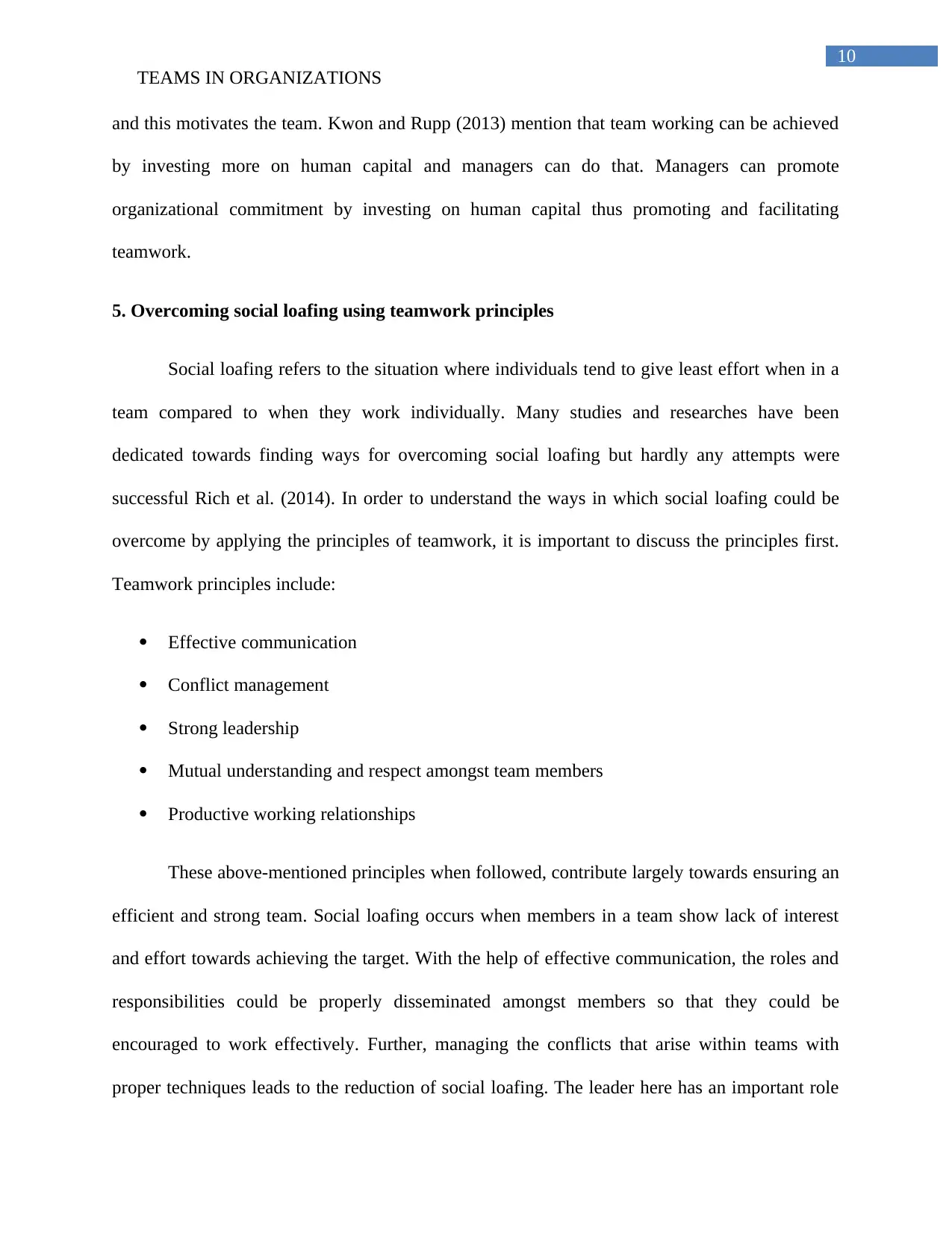
10
TEAMS IN ORGANIZATIONS
and this motivates the team. Kwon and Rupp (2013) mention that team working can be achieved
by investing more on human capital and managers can do that. Managers can promote
organizational commitment by investing on human capital thus promoting and facilitating
teamwork.
5. Overcoming social loafing using teamwork principles
Social loafing refers to the situation where individuals tend to give least effort when in a
team compared to when they work individually. Many studies and researches have been
dedicated towards finding ways for overcoming social loafing but hardly any attempts were
successful Rich et al. (2014). In order to understand the ways in which social loafing could be
overcome by applying the principles of teamwork, it is important to discuss the principles first.
Teamwork principles include:
Effective communication
Conflict management
Strong leadership
Mutual understanding and respect amongst team members
Productive working relationships
These above-mentioned principles when followed, contribute largely towards ensuring an
efficient and strong team. Social loafing occurs when members in a team show lack of interest
and effort towards achieving the target. With the help of effective communication, the roles and
responsibilities could be properly disseminated amongst members so that they could be
encouraged to work effectively. Further, managing the conflicts that arise within teams with
proper techniques leads to the reduction of social loafing. The leader here has an important role
TEAMS IN ORGANIZATIONS
and this motivates the team. Kwon and Rupp (2013) mention that team working can be achieved
by investing more on human capital and managers can do that. Managers can promote
organizational commitment by investing on human capital thus promoting and facilitating
teamwork.
5. Overcoming social loafing using teamwork principles
Social loafing refers to the situation where individuals tend to give least effort when in a
team compared to when they work individually. Many studies and researches have been
dedicated towards finding ways for overcoming social loafing but hardly any attempts were
successful Rich et al. (2014). In order to understand the ways in which social loafing could be
overcome by applying the principles of teamwork, it is important to discuss the principles first.
Teamwork principles include:
Effective communication
Conflict management
Strong leadership
Mutual understanding and respect amongst team members
Productive working relationships
These above-mentioned principles when followed, contribute largely towards ensuring an
efficient and strong team. Social loafing occurs when members in a team show lack of interest
and effort towards achieving the target. With the help of effective communication, the roles and
responsibilities could be properly disseminated amongst members so that they could be
encouraged to work effectively. Further, managing the conflicts that arise within teams with
proper techniques leads to the reduction of social loafing. The leader here has an important role
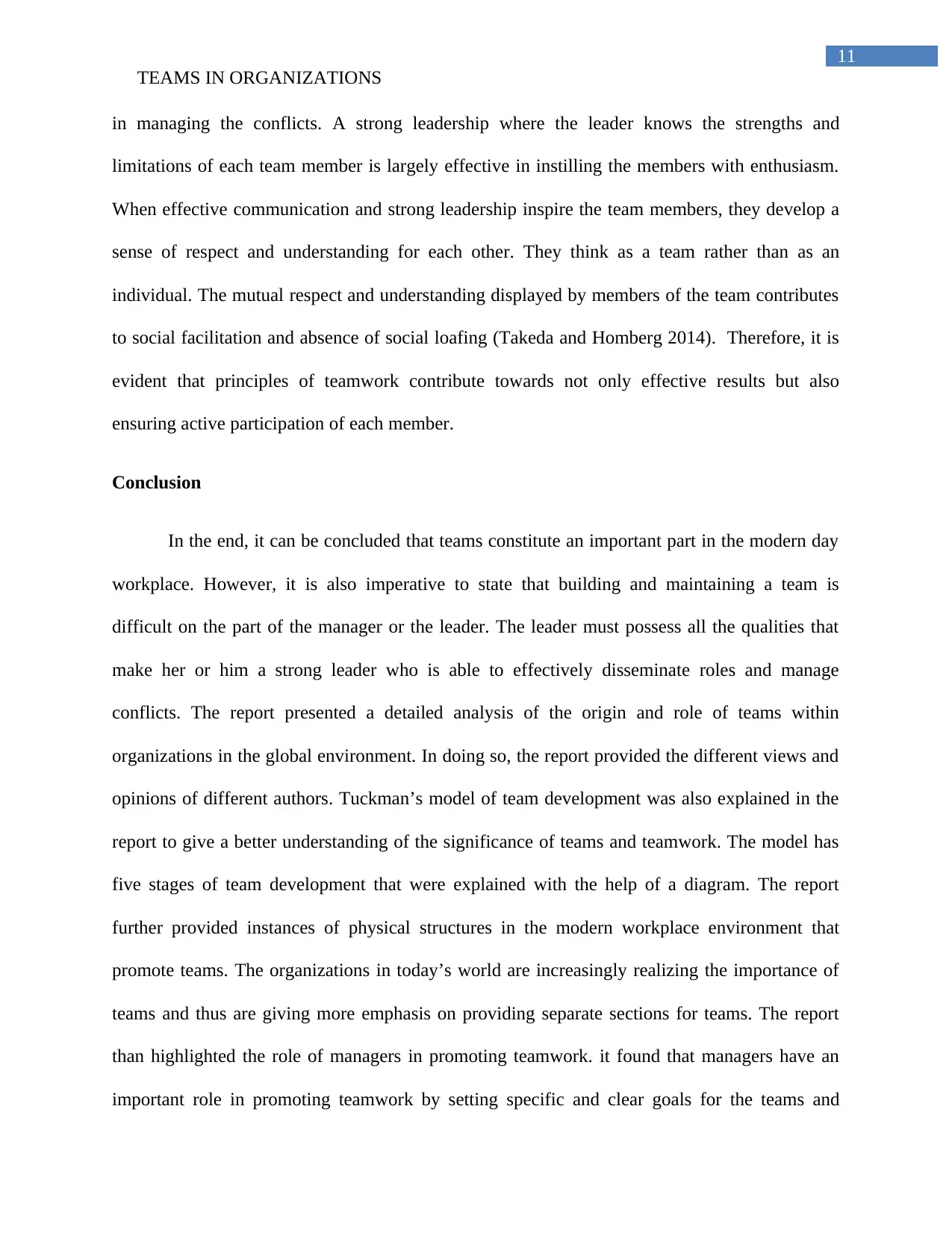
11
TEAMS IN ORGANIZATIONS
in managing the conflicts. A strong leadership where the leader knows the strengths and
limitations of each team member is largely effective in instilling the members with enthusiasm.
When effective communication and strong leadership inspire the team members, they develop a
sense of respect and understanding for each other. They think as a team rather than as an
individual. The mutual respect and understanding displayed by members of the team contributes
to social facilitation and absence of social loafing (Takeda and Homberg 2014). Therefore, it is
evident that principles of teamwork contribute towards not only effective results but also
ensuring active participation of each member.
Conclusion
In the end, it can be concluded that teams constitute an important part in the modern day
workplace. However, it is also imperative to state that building and maintaining a team is
difficult on the part of the manager or the leader. The leader must possess all the qualities that
make her or him a strong leader who is able to effectively disseminate roles and manage
conflicts. The report presented a detailed analysis of the origin and role of teams within
organizations in the global environment. In doing so, the report provided the different views and
opinions of different authors. Tuckman’s model of team development was also explained in the
report to give a better understanding of the significance of teams and teamwork. The model has
five stages of team development that were explained with the help of a diagram. The report
further provided instances of physical structures in the modern workplace environment that
promote teams. The organizations in today’s world are increasingly realizing the importance of
teams and thus are giving more emphasis on providing separate sections for teams. The report
than highlighted the role of managers in promoting teamwork. it found that managers have an
important role in promoting teamwork by setting specific and clear goals for the teams and
TEAMS IN ORGANIZATIONS
in managing the conflicts. A strong leadership where the leader knows the strengths and
limitations of each team member is largely effective in instilling the members with enthusiasm.
When effective communication and strong leadership inspire the team members, they develop a
sense of respect and understanding for each other. They think as a team rather than as an
individual. The mutual respect and understanding displayed by members of the team contributes
to social facilitation and absence of social loafing (Takeda and Homberg 2014). Therefore, it is
evident that principles of teamwork contribute towards not only effective results but also
ensuring active participation of each member.
Conclusion
In the end, it can be concluded that teams constitute an important part in the modern day
workplace. However, it is also imperative to state that building and maintaining a team is
difficult on the part of the manager or the leader. The leader must possess all the qualities that
make her or him a strong leader who is able to effectively disseminate roles and manage
conflicts. The report presented a detailed analysis of the origin and role of teams within
organizations in the global environment. In doing so, the report provided the different views and
opinions of different authors. Tuckman’s model of team development was also explained in the
report to give a better understanding of the significance of teams and teamwork. The model has
five stages of team development that were explained with the help of a diagram. The report
further provided instances of physical structures in the modern workplace environment that
promote teams. The organizations in today’s world are increasingly realizing the importance of
teams and thus are giving more emphasis on providing separate sections for teams. The report
than highlighted the role of managers in promoting teamwork. it found that managers have an
important role in promoting teamwork by setting specific and clear goals for the teams and
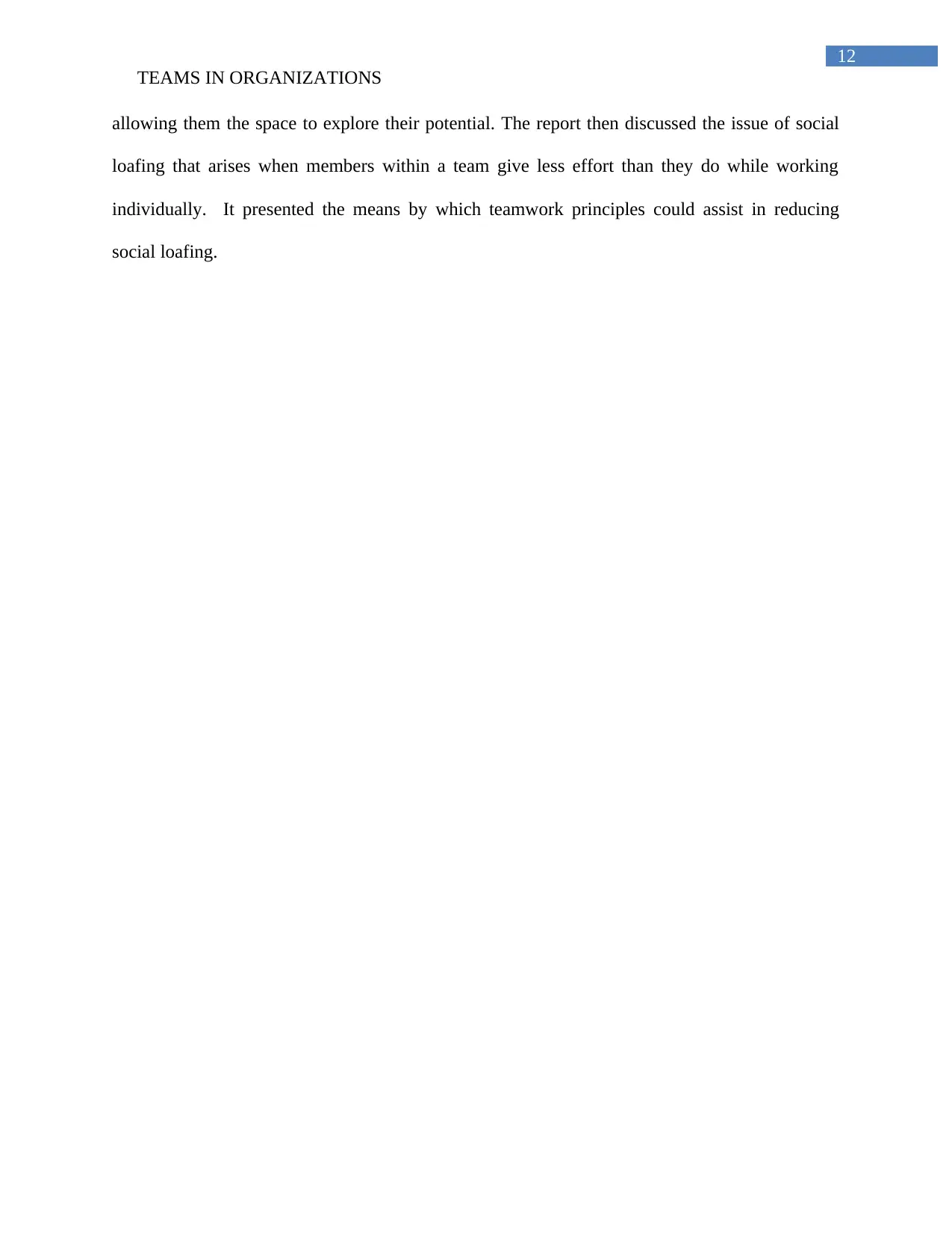
12
TEAMS IN ORGANIZATIONS
allowing them the space to explore their potential. The report then discussed the issue of social
loafing that arises when members within a team give less effort than they do while working
individually. It presented the means by which teamwork principles could assist in reducing
social loafing.
TEAMS IN ORGANIZATIONS
allowing them the space to explore their potential. The report then discussed the issue of social
loafing that arises when members within a team give less effort than they do while working
individually. It presented the means by which teamwork principles could assist in reducing
social loafing.
Paraphrase This Document
Need a fresh take? Get an instant paraphrase of this document with our AI Paraphraser
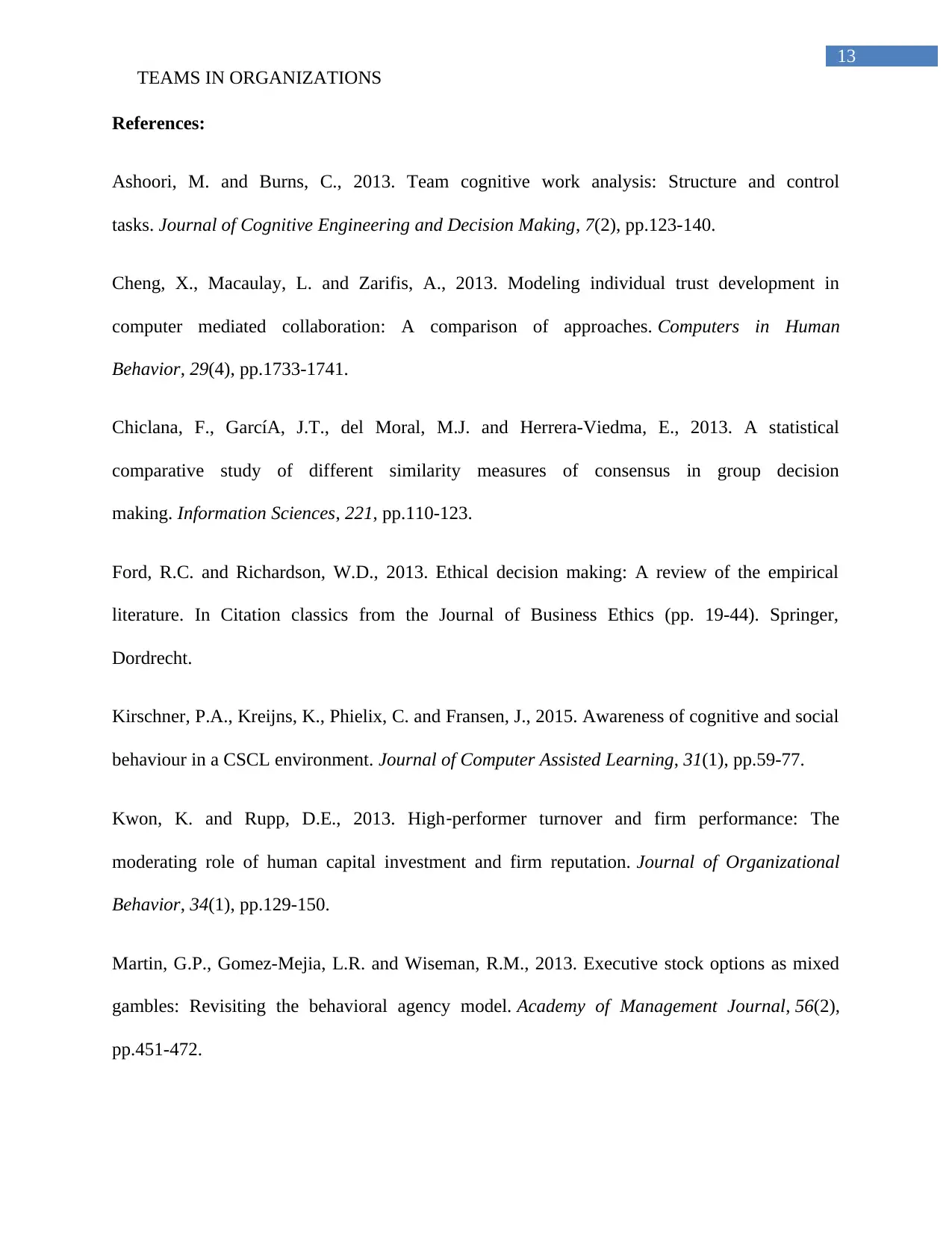
13
TEAMS IN ORGANIZATIONS
References:
Ashoori, M. and Burns, C., 2013. Team cognitive work analysis: Structure and control
tasks. Journal of Cognitive Engineering and Decision Making, 7(2), pp.123-140.
Cheng, X., Macaulay, L. and Zarifis, A., 2013. Modeling individual trust development in
computer mediated collaboration: A comparison of approaches. Computers in Human
Behavior, 29(4), pp.1733-1741.
Chiclana, F., GarcíA, J.T., del Moral, M.J. and Herrera-Viedma, E., 2013. A statistical
comparative study of different similarity measures of consensus in group decision
making. Information Sciences, 221, pp.110-123.
Ford, R.C. and Richardson, W.D., 2013. Ethical decision making: A review of the empirical
literature. In Citation classics from the Journal of Business Ethics (pp. 19-44). Springer,
Dordrecht.
Kirschner, P.A., Kreijns, K., Phielix, C. and Fransen, J., 2015. Awareness of cognitive and social
behaviour in a CSCL environment. Journal of Computer Assisted Learning, 31(1), pp.59-77.
Kwon, K. and Rupp, D.E., 2013. High‐performer turnover and firm performance: The
moderating role of human capital investment and firm reputation. Journal of Organizational
Behavior, 34(1), pp.129-150.
Martin, G.P., Gomez-Mejia, L.R. and Wiseman, R.M., 2013. Executive stock options as mixed
gambles: Revisiting the behavioral agency model. Academy of Management Journal, 56(2),
pp.451-472.
TEAMS IN ORGANIZATIONS
References:
Ashoori, M. and Burns, C., 2013. Team cognitive work analysis: Structure and control
tasks. Journal of Cognitive Engineering and Decision Making, 7(2), pp.123-140.
Cheng, X., Macaulay, L. and Zarifis, A., 2013. Modeling individual trust development in
computer mediated collaboration: A comparison of approaches. Computers in Human
Behavior, 29(4), pp.1733-1741.
Chiclana, F., GarcíA, J.T., del Moral, M.J. and Herrera-Viedma, E., 2013. A statistical
comparative study of different similarity measures of consensus in group decision
making. Information Sciences, 221, pp.110-123.
Ford, R.C. and Richardson, W.D., 2013. Ethical decision making: A review of the empirical
literature. In Citation classics from the Journal of Business Ethics (pp. 19-44). Springer,
Dordrecht.
Kirschner, P.A., Kreijns, K., Phielix, C. and Fransen, J., 2015. Awareness of cognitive and social
behaviour in a CSCL environment. Journal of Computer Assisted Learning, 31(1), pp.59-77.
Kwon, K. and Rupp, D.E., 2013. High‐performer turnover and firm performance: The
moderating role of human capital investment and firm reputation. Journal of Organizational
Behavior, 34(1), pp.129-150.
Martin, G.P., Gomez-Mejia, L.R. and Wiseman, R.M., 2013. Executive stock options as mixed
gambles: Revisiting the behavioral agency model. Academy of Management Journal, 56(2),
pp.451-472.
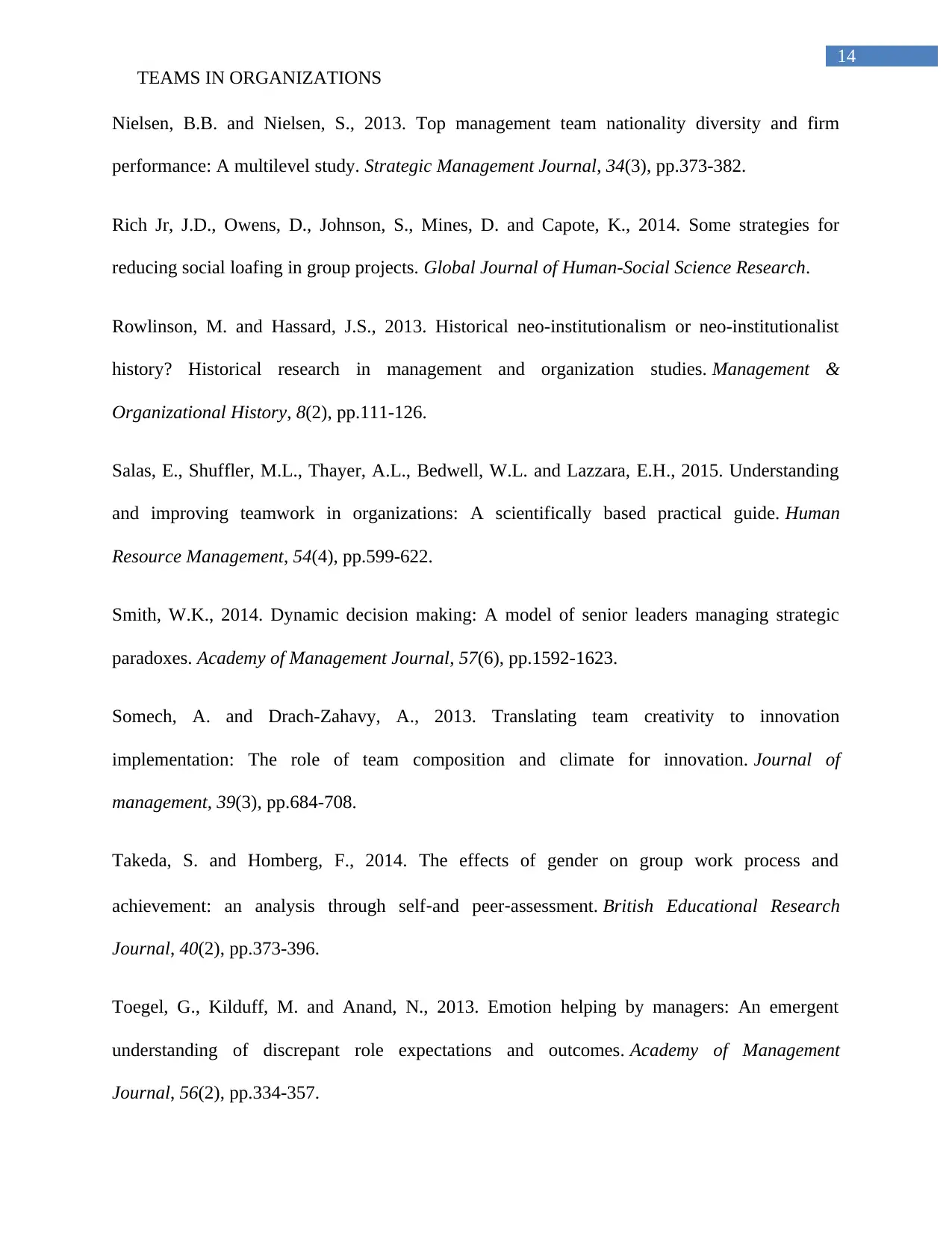
14
TEAMS IN ORGANIZATIONS
Nielsen, B.B. and Nielsen, S., 2013. Top management team nationality diversity and firm
performance: A multilevel study. Strategic Management Journal, 34(3), pp.373-382.
Rich Jr, J.D., Owens, D., Johnson, S., Mines, D. and Capote, K., 2014. Some strategies for
reducing social loafing in group projects. Global Journal of Human-Social Science Research.
Rowlinson, M. and Hassard, J.S., 2013. Historical neo-institutionalism or neo-institutionalist
history? Historical research in management and organization studies. Management &
Organizational History, 8(2), pp.111-126.
Salas, E., Shuffler, M.L., Thayer, A.L., Bedwell, W.L. and Lazzara, E.H., 2015. Understanding
and improving teamwork in organizations: A scientifically based practical guide. Human
Resource Management, 54(4), pp.599-622.
Smith, W.K., 2014. Dynamic decision making: A model of senior leaders managing strategic
paradoxes. Academy of Management Journal, 57(6), pp.1592-1623.
Somech, A. and Drach-Zahavy, A., 2013. Translating team creativity to innovation
implementation: The role of team composition and climate for innovation. Journal of
management, 39(3), pp.684-708.
Takeda, S. and Homberg, F., 2014. The effects of gender on group work process and
achievement: an analysis through self‐and peer‐assessment. British Educational Research
Journal, 40(2), pp.373-396.
Toegel, G., Kilduff, M. and Anand, N., 2013. Emotion helping by managers: An emergent
understanding of discrepant role expectations and outcomes. Academy of Management
Journal, 56(2), pp.334-357.
TEAMS IN ORGANIZATIONS
Nielsen, B.B. and Nielsen, S., 2013. Top management team nationality diversity and firm
performance: A multilevel study. Strategic Management Journal, 34(3), pp.373-382.
Rich Jr, J.D., Owens, D., Johnson, S., Mines, D. and Capote, K., 2014. Some strategies for
reducing social loafing in group projects. Global Journal of Human-Social Science Research.
Rowlinson, M. and Hassard, J.S., 2013. Historical neo-institutionalism or neo-institutionalist
history? Historical research in management and organization studies. Management &
Organizational History, 8(2), pp.111-126.
Salas, E., Shuffler, M.L., Thayer, A.L., Bedwell, W.L. and Lazzara, E.H., 2015. Understanding
and improving teamwork in organizations: A scientifically based practical guide. Human
Resource Management, 54(4), pp.599-622.
Smith, W.K., 2014. Dynamic decision making: A model of senior leaders managing strategic
paradoxes. Academy of Management Journal, 57(6), pp.1592-1623.
Somech, A. and Drach-Zahavy, A., 2013. Translating team creativity to innovation
implementation: The role of team composition and climate for innovation. Journal of
management, 39(3), pp.684-708.
Takeda, S. and Homberg, F., 2014. The effects of gender on group work process and
achievement: an analysis through self‐and peer‐assessment. British Educational Research
Journal, 40(2), pp.373-396.
Toegel, G., Kilduff, M. and Anand, N., 2013. Emotion helping by managers: An emergent
understanding of discrepant role expectations and outcomes. Academy of Management
Journal, 56(2), pp.334-357.
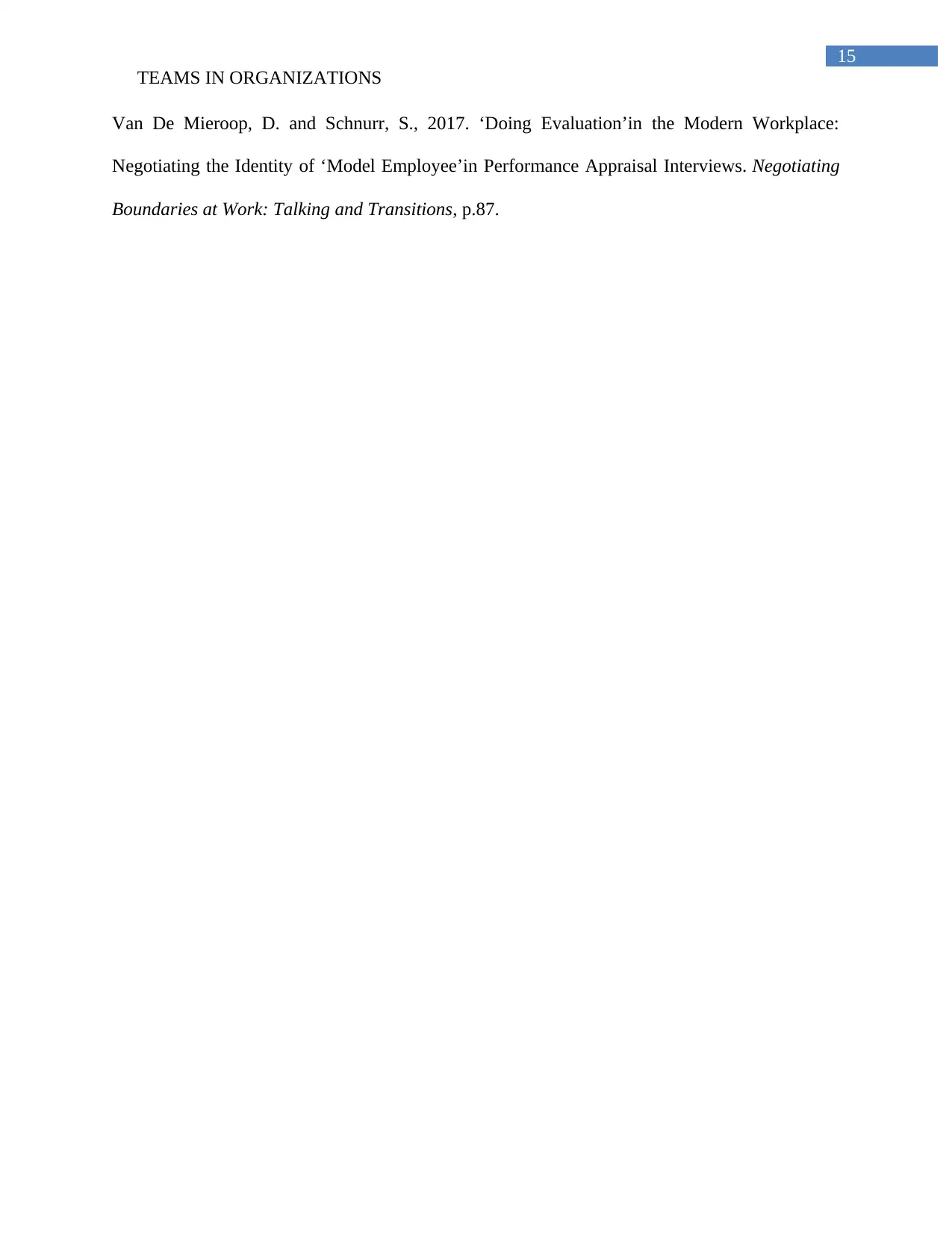
15
TEAMS IN ORGANIZATIONS
Van De Mieroop, D. and Schnurr, S., 2017. ‘Doing Evaluation’in the Modern Workplace:
Negotiating the Identity of ‘Model Employee’in Performance Appraisal Interviews. Negotiating
Boundaries at Work: Talking and Transitions, p.87.
TEAMS IN ORGANIZATIONS
Van De Mieroop, D. and Schnurr, S., 2017. ‘Doing Evaluation’in the Modern Workplace:
Negotiating the Identity of ‘Model Employee’in Performance Appraisal Interviews. Negotiating
Boundaries at Work: Talking and Transitions, p.87.
1 out of 16
Related Documents
Your All-in-One AI-Powered Toolkit for Academic Success.
+13062052269
info@desklib.com
Available 24*7 on WhatsApp / Email
![[object Object]](/_next/static/media/star-bottom.7253800d.svg)
Unlock your academic potential
© 2024 | Zucol Services PVT LTD | All rights reserved.





